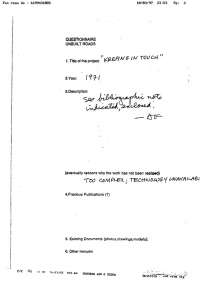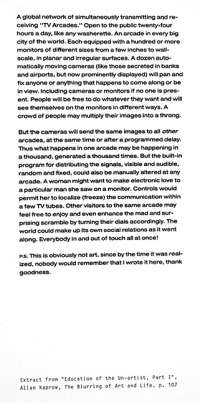A global network of simultaneously transmitting and receiving " TV Arcades." Open to the public twenty-four hours a day, like any washerette. An arcade in every big city of the world. Each equipped with a hundred or more monitors of different sizes from a few inches to wall-scale, in planar and irregular surfaces. A dozen auto-matically moving cameras (like those secreted in banks and airports, but now prominently displayed) will pan and fix anyone or anything that happens to come along or be in view. Including cameras or monitors if no one is present. People will be free to do whatever they want and will see themselves on the monitors in different ways. A crowd of people may multiply their images into a throng.
But the cameras will send the same images to all other arcades, at the same time or after a programmed delay. Thus what happens in one arcade may be happening in a thousand, generated a thousand times. But the built-in program for distributing the signals, visible and audible, random and fixed, could also be manually altered at any arcade. A woman might want to make electronic love to a particular man she saw on a monitor. Controls would permit her to localize (freeze) the communication within a few TV tubes. Other visitors to the same arcade may feel free to enjoy and even enhance the mad and surprising scramble by turning their dials accordingly. The world could make up its own social relations as it went along. Everybody in and out of touch all at once!
P.s. This is obviously not art, since by the time it was realized, nobody would remember that I wrote it here, thank goodness.
Extract from ''Education of the Un-artist, Part 1 , Allan Kaprow, The Blurring of Art and Life, p. 107
see bibliographic note indidcated, enclosed
(eventually reasons why the work has not been realised)
TOO COMPLEX; TECHNOLOGY UNAVAILABLE
A global network of simultaneously transmitting and receiving " TV Arcades." Open to the public twenty-four hours a day, like any washerette. An arcade in every big city of the world. Each equipped with a hundred or more monitors of different sizes from a few inches to wall-scale, in planar and irregular surfaces. A dozen auto-matically moving cameras (like those secreted in banks and airports, but now prominently displayed) will pan and fix anyone or anything that happens to come along or be in view. Including cameras or monitors if no one is present. People will be free to do whatever they want and will see themselves on the monitors in different ways. A crowd of people may multiply their images into a throng.
But the cameras will send the same images to all other arcades, at the same time or after a programmed delay. Thus what happens in one arcade may be happening in a thousand, generated a thousand times. But the built-in program for distributing the signals, visible and audible, random and fixed, could also be manually altered at any arcade. A woman might want to make electronic love to a particular man she saw on a monitor. Controls would permit her to localize (freeze) the communication within a few TV tubes. Other visitors to the same arcade may feel free to enjoy and even enhance the mad and surprising scramble by turning their dials accordingly. The world could make up its own social relations as it went along. Everybody in and out of touch all at once!
P.s. This is obviously not art, since by the time it was realized, nobody would remember that I wrote it here, thank goodness.
Extract from ''Education of the Un-artist, Part 1 , Allan Kaprow, The Blurring of Art and Life, p. 107
see bibliographic note indidcated, enclosed
(eventually reasons why the work has not been realised)
TOO COMPLEX; TECHNOLOGY UNAVAILABLE

